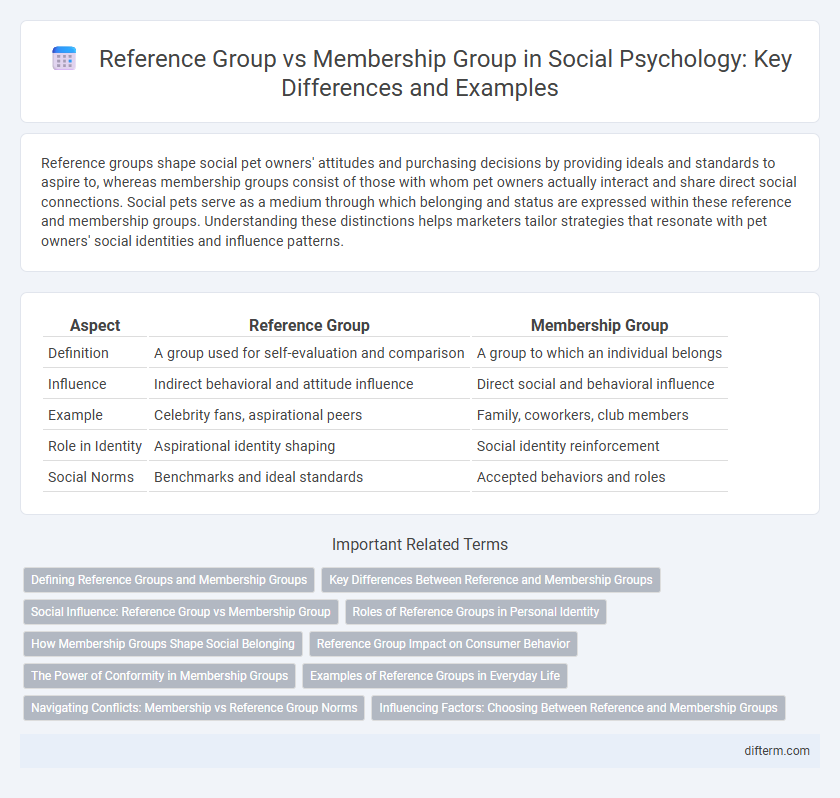Reference groups shape social pet owners' attitudes and purchasing decisions by providing ideals and standards to aspire to, whereas membership groups consist of those with whom pet owners actually interact and share direct social connections. Social pets serve as a medium through which belonging and status are expressed within these reference and membership groups. Understanding these distinctions helps marketers tailor strategies that resonate with pet owners' social identities and influence patterns.
Table of Comparison
| Aspect | Reference Group | Membership Group |
|---|---|---|
| Definition | A group used for self-evaluation and comparison | A group to which an individual belongs |
| Influence | Indirect behavioral and attitude influence | Direct social and behavioral influence |
| Example | Celebrity fans, aspirational peers | Family, coworkers, club members |
| Role in Identity | Aspirational identity shaping | Social identity reinforcement |
| Social Norms | Benchmarks and ideal standards | Accepted behaviors and roles |
Defining Reference Groups and Membership Groups
Reference groups influence individual attitudes and behaviors by serving as a standard for self-evaluation, often encompassing aspirational or comparative social circles beyond direct membership. Membership groups consist of individuals who belong to the same social category, providing a sense of identity and belonging through shared norms and values. Understanding the distinction between reference and membership groups is essential for analyzing social influences and consumer behavior patterns.
Key Differences Between Reference and Membership Groups
Reference groups influence an individual's attitudes, values, and behaviors by serving as a point of comparison, even if the individual does not belong to them, whereas membership groups consist of social groups to which the individual actually belongs. Membership groups provide direct social interaction and a sense of belonging, impacting self-identity through actual participation. Reference groups often shape aspirations and aspirations-related behaviors, while membership groups reinforce social norms through ongoing membership and engagement.
Social Influence: Reference Group vs Membership Group
Reference groups shape individual attitudes and behaviors by serving as a standard for comparison, often influencing aspirations and social norms beyond direct group membership. Membership groups consist of individuals with whom one shares actual participation, reinforcing social identity and promoting conformity through shared experiences and ongoing interaction. Social influence from reference groups tends to be more aspirational and idealized, while membership groups exert influence through immediate social ties and direct behavioral expectations.
Roles of Reference Groups in Personal Identity
Reference groups shape personal identity by influencing beliefs, values, and behaviors directly through comparison and aspiration, often defining ideal or desired traits. Unlike membership groups, which are those to which individuals currently belong and gain a sense of belonging, reference groups function as social benchmarks that guide self-evaluation and role adoption. This dynamic helps individuals navigate social norms and construct a coherent self-concept aligned with or opposing specific group standards.
How Membership Groups Shape Social Belonging
Membership groups directly influence social belonging by providing individuals with a sense of identity and acceptance through shared norms and values. These groups, such as family, peers, or professional associations, establish behavioral expectations that reinforce social cohesion. Unlike reference groups that serve as aspirational models, membership groups offer immediate belonging and social validation within a community.
Reference Group Impact on Consumer Behavior
Reference groups significantly influence consumer behavior by shaping attitudes, preferences, and purchasing decisions through social comparison and normative pressure. Unlike membership groups, where individuals belong and directly interact, reference groups serve as points of aspiration or evaluation, impacting brand perception and product adoption. Marketers leverage this influence by targeting aspirational reference groups to enhance brand appeal and consumer loyalty.
The Power of Conformity in Membership Groups
Membership groups exert significant influence through conformity, as individuals align their behaviors, attitudes, and values to fit group norms. This power of conformity strengthens social identity and reinforces group cohesion, driving members to adopt shared practices naturally. Understanding this dynamic helps marketers and social scientists predict consumer behavior and social trends within specific communities.
Examples of Reference Groups in Everyday Life
Reference groups in everyday life include celebrities, social media influencers, and professional role models whose opinions and behaviors individuals aspire to emulate. Membership groups consist of immediate social circles like family, close friends, and coworkers, where individuals actively participate and share common goals or interests. Understanding the distinction highlights how reference groups shape attitudes and aspirations without direct interaction, unlike membership groups that influence behavior through ongoing relationships.
Navigating Conflicts: Membership vs Reference Group Norms
Navigating conflicts between membership and reference group norms requires understanding their distinct influences on individual behavior. Membership groups enforce direct social expectations based on actual participation, while reference groups provide aspirational or comparative standards that shape attitudes and choices indirectly. Aligning behavior often involves balancing loyalty to membership group norms with the desire for approval or identity affirmation from reference groups.
Influencing Factors: Choosing Between Reference and Membership Groups
Reference groups influence individuals through aspirational identification, shaping attitudes and behaviors by setting standards and social norms, whereas membership groups impact through direct interaction and shared experiences. Factors such as self-concept clarity, social mobility aspirations, and situational context determine whether an individual aligns with a reference or membership group. Psychological needs for belongingness, group attractiveness, and perceived group relevance further drive the choice between these social groups.
reference group vs membership group Infographic

 difterm.com
difterm.com